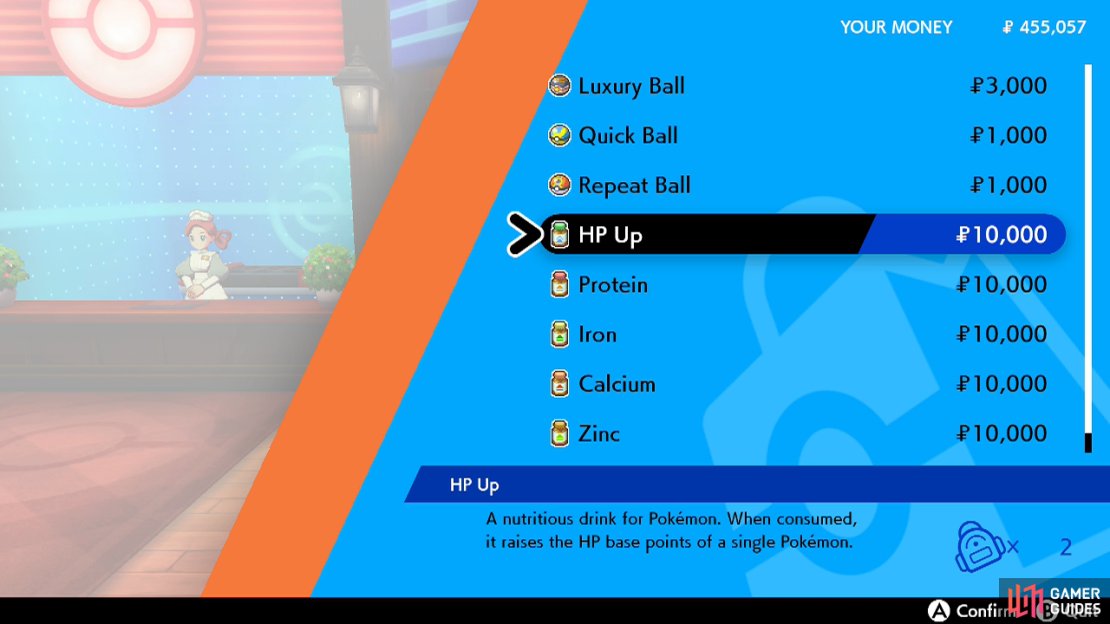Press the X Button when checking a Pokémon’s stats to view their EVs.
If Individual Values represent a Pokémon’s natural talent, Effort Values (or EVs for short) reflect the hard work and training put in by the Pokémon.
In a similar manner to IVs, each Pokémon has an EV in each of the six key stats (HP through Speed). To begin with, EVs are set to 0 in all stats (although there are exceptions).
As your Pokémon battles and defeats other Pokémon, that Pokémon will gradually gain EVs depending on the species of Pokémon defeated. Weak Pokémon generally award 1 EV in a certain stat, while stronger ones can award 2 or even 3 EVs.
EVs can be gained at any time, even if a Pokémon is Level 100. However, EVs cannot be endlessly gained. Pokémon can gain a maximum of 252 EVs in a single stat and, on top of that, each Pokémon is restricted to a total of 510 EVs spread between all stats.
The EV Advantage¶
Unlike Nature and IVs, it should be clear that EVs can be freely customised. Although, as with IVs, you don’t need to concern yourself with EVs during the main story, as their influence is hardly felt. Plus it would be a nightmare to manage your Pokémon’s EVs! Only after you’ve cleared the story, should you consider your plans.
At Level 100, a Pokémon gains 1 stat point for every 4 EVs accumulated (while at lower levels, the gain is proportionally smaller). Since a Pokémon can gain up to 252 EVs in one stat, that equates to a maximum stat boost of 63 in a single stat.
Before, we said a difference of 31 stat points was a big deal, so this is a big, BIG deal. Not to mention you’re allowed 510 total EVs, so you can have a second stat boosted by 63 points and a third stat boosted by 1 point (which is tiny, but better than nothing).
Needless to say, comparing a run-of-the-mill Pokémon taken from the main story that has a random Nature and IVs and unoptimised EVs with a hardcore trainer’s Pokémon that has a carefully selected Nature, the best IVs and optimised EVs is like looking at night and day!
Manipulating EVs¶
You can buy vitamins from the BP Shop in the first Hammerlocke Pokémon Centre or the Poké Mart clerk in the first Wyndon Pokémon Centre.
Alright, so we’ve hopefully sold you on EVs, but how exactly do you customise your Pokémon’s EVs? Is it even possible? Well, of course or we wouldn’t be here!
-
EV Training is where you identify which species gives what EVs, then focus on defeating that species. As mentioned, each Pokémon species awards 1 to 3 EVs in a given stat. Normally, it can take a long time before you reach 252 EVs. However, if your Pokémon has a “Power” item (eg. Power Anklet), they can gain an extra 8 EVs at the cost of having temporarily reduced Speed.
-
Outside of battles, you can feed your Pokémon vitamins such as Calcium and Carbos, which boosts EVs by 10 points in the specified stat. Trouble is, these items are expensive, although if you’re rich, that’s not a concern. There are also wing items, like Genius Wing, but they boost EVs by 1 point each, which is tiny, and there’s no way to easily obtain them.
-
Moving onto newer methods, once you’ve obtained 4 Gym badges, you can use Poké Jobs to passively EV train multiple Pokémon, while you do other things or close the game. Pokémon will gain 4 EVs per hour in the chosen stat, which is a tad slow. But if you give your Pokémon a “Power” item, they can gain 12 EVs per hour instead, reaching the max in 24 hours.


No Comments